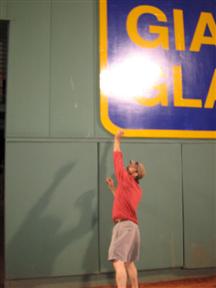Monday, June 28, 2004
curves, magnus forces, and deflected wakes, oh my!
it seems there are some out there that doubt that a curve ball actually does curve. while this topic might seem to be outside the bailiwick of this blog (due to its lack of either large mammaries, gaming or canine aspects), there is quite a bit a material on this topic that seems worthy of sharing.
it seems that this belief may have been fostered by an article that Life published in september of 1941 where it was concluded that "a baseball is so heavy an object . . . that the pitcher's spinning action appears to be insufficiently strong to appreciably change its course."
perhaps the pictures that accompanied this misstatement were so lush and evocative that the patent inaccuracy slipped by.
in 1982, Science reached a similar conclusion, referring to the "apparent break in a curveball" as an "illusion".
in the context of researching this topic (read: time-wasting) the reason for the persistence of this line of thinking emerged as something like the following. there is in fact an illusionary component that contributes significantly to the effectiveness of breaking pitches, which in fact have been proven to curve by more aerodynamicists than you can shake a stick at, if you for some reason get your jollies from shaking sticks at fusty people in labcoats.
let's take the two components in turn, starting with the question of if a curve ball actually curves.
a cocktail party level summary (does anyone really go to cocktail parties any more?):
the spin imparted on the ball creates a difference in pressure via the "magnus force".
(dirty harry comes out of retirement to settle some unfinished hurling business, and plays some jazz piano along the way. summer, 2005.)
much data backing up this claim is available in the links below, and in the links on the linked pages, and the links on those pages as well, weaving together into a veritable "web" of information, almost a superhighway of information.
now, on to the optical illusion aspect of breaking pitches.
a curve ball's deviation from the path it would be expected to take if it were thrown without the necessary spin is shown below.
however, from the perspective of aerodynamics/physics/science, the only important deviation is between the actual path of the thrown curveball, and the straight line between the release point and where the ball actually crosses the plate. (the thin gray line in the picture above) this difference (called the sagitta) is a considerably less butch 3.4 inches.
so, expectations play a role in enhancing the effectiveness of the curve. the batter is comparing the breaking pitch that is on its way with the path of a fastball that is sadly not in the offing. also consider that there is an amount of time where the batter doesn't know what pitch is coming. the curve is happily curving during all that calculating time, moving further away from the unthrown fastball's path so that, by the time the batter picks up the spin, (or processes the change in arm action/wrist turn, or whatever mechanism he uses to identify a curve ball) he is engaged in an unfortunate game of catchup. this phenomenon, coupled with the fact that a breaking pitch actually does most of its curving towards the end of its trip to the plate, results in the perception of a hella big, hella late break.
as if all these factors weren't enough, the ball is all the while traveling closer and closer to the batter, using foreshortening to amplify all the perceived distances.
also, someone might be skeptical of a thrown ball's ability to actually curve, while accepting that batted balls hook and slice due to the magnitude of the comparative forces involved.
it seems that this belief may have been fostered by an article that Life published in september of 1941 where it was concluded that "a baseball is so heavy an object . . . that the pitcher's spinning action appears to be insufficiently strong to appreciably change its course."
perhaps the pictures that accompanied this misstatement were so lush and evocative that the patent inaccuracy slipped by.
in 1982, Science reached a similar conclusion, referring to the "apparent break in a curveball" as an "illusion".
in the context of researching this topic (read: time-wasting) the reason for the persistence of this line of thinking emerged as something like the following. there is in fact an illusionary component that contributes significantly to the effectiveness of breaking pitches, which in fact have been proven to curve by more aerodynamicists than you can shake a stick at, if you for some reason get your jollies from shaking sticks at fusty people in labcoats.
let's take the two components in turn, starting with the question of if a curve ball actually curves.


a cocktail party level summary (does anyone really go to cocktail parties any more?):
the spin imparted on the ball creates a difference in pressure via the "magnus force".
(dirty harry comes out of retirement to settle some unfinished hurling business, and plays some jazz piano along the way. summer, 2005.)
much data backing up this claim is available in the links below, and in the links on the linked pages, and the links on those pages as well, weaving together into a veritable "web" of information, almost a superhighway of information.
now, on to the optical illusion aspect of breaking pitches.
a curve ball's deviation from the path it would be expected to take if it were thrown without the necessary spin is shown below.

however, from the perspective of aerodynamics/physics/science, the only important deviation is between the actual path of the thrown curveball, and the straight line between the release point and where the ball actually crosses the plate. (the thin gray line in the picture above) this difference (called the sagitta) is a considerably less butch 3.4 inches.
so, expectations play a role in enhancing the effectiveness of the curve. the batter is comparing the breaking pitch that is on its way with the path of a fastball that is sadly not in the offing. also consider that there is an amount of time where the batter doesn't know what pitch is coming. the curve is happily curving during all that calculating time, moving further away from the unthrown fastball's path so that, by the time the batter picks up the spin, (or processes the change in arm action/wrist turn, or whatever mechanism he uses to identify a curve ball) he is engaged in an unfortunate game of catchup. this phenomenon, coupled with the fact that a breaking pitch actually does most of its curving towards the end of its trip to the plate, results in the perception of a hella big, hella late break.
as if all these factors weren't enough, the ball is all the while traveling closer and closer to the batter, using foreshortening to amplify all the perceived distances.
- selected links:
- Do curveballs really curve? (The Straight Dope)
probably the most concise summary - Dizzy Dean Right: It Ain't No Optical Illusion for Batters!
written in 1959 - Aerodynamics & Curve Balls
account of one of the first attempts to address this question scientifically - The Physics behind Baseball: THE CURVE BALL
probably the best link with regard to detail - Thrown for a Curve
from the excellent exploratorium site - Does A Curve Ball Really Curve?
balance of history and lite science - Does the Ball Really Curve?
a particularly good illustration of the sagitta v. straight line - The Mechanics Of A Breaking Pitch by former major league pitcher (and major league grouch, it seems) jim kaat
- Dr. LeRoy W. Alaways' Dissertation: Aerodynamics of the Curve-Ball
1 MB acrobat pdf, could be slow loading. you might have better results right clicking this link and selecting "save target as.." from the context menu. it is also really techincal, including much math and, sadly, no big juggs. (unless you count the juggs pitching machine he used for some of his data collection.) - The Physics of Baseball
an excellent book that covers the operative forces of pitches and many many other aspects of balls in flight in an accessible, yet rigorous, manner
also, someone might be skeptical of a thrown ball's ability to actually curve, while accepting that batted balls hook and slice due to the magnitude of the comparative forces involved.

